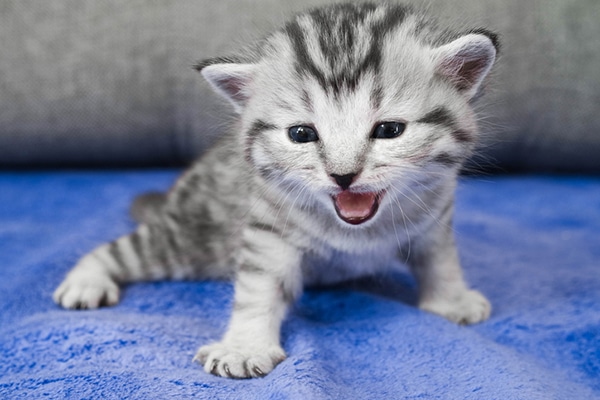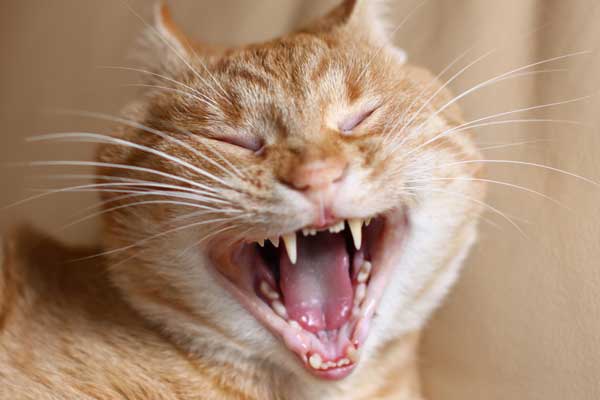Cat teeth are important structures in our felines. They serve a number of purposes: prehension (grasping and holding food), mastication (chewing food) and as weapons for killing prey and for biting veterinarians. (I speak from experience.) I’ve compiled all you need to know about your cat’s teeth into this easy-to-read primer.
1. Cat teeth and kittenhood

Kittens are born toothless. At 1 to 2 weeks of age, the deciduous teeth (better known as “baby teeth”) erupt through the gums. By 6 weeks of age, all 26 baby teeth are present. At 4 to 5 months of age, the baby teeth begin falling out. By 6 months of age, all 30 adult teeth are fully erupted. These teeth include 12 tiny incisors in front, four “fangs” (the upper and lower canine teeth), 10 pre-molars and four molars.
2. Placement of cat teeth
Each tooth sits in a socket in the bone of the upper jaw (maxilla) or lower jaw (mandible).
3. Attachment
The tooth is held firmly in place by the periodontal ligament, which attaches the tooth to the surrounding gums.
4. Visible vs. invisible cat teeth
The visible part of the tooth is the crown. Below the gums is where you’ll find the roots. The point at which the crown and the root meet is the neck of the tooth.
5. Components of a cat tooth
Each tooth consists of three parts: the pulp cavity, dentine and enamel. The pulp cavity lies in the center of the tooth. This is where the nerves and blood vessels are found. Surrounding the pulp is dentine, a hard, sensitive substance that protects the pulp. The outer layer is the enamel, a very hard, mineralized substance that covers the crown. Enamel contains no nerves and is not sensitive.
6. Physical signs of dental disease in cats
Dental disease is one of the most common problems encountered in veterinary medicine. It can lead to bad breath, drooling, loose teeth, bleeding gums and difficulty eating. If untreated, diseases of the teeth and gums are not only painful for the cat, but they may lead to other oral or systemic problems.
7. Behavioral signs of dental disease in cats
Because cats are secretive by nature, it can be difficult for a cat owner to know for sure if a cat is experiencing dental or oral pain. Sometimes, a cat will reveal that his mouth is hurting by:
- Pawing at the mouth.
- Turning his head to one side when he eats, to avoid chewing on the side that’s painful stopping eating.
- Stopping eating dry food and only eating wet food. (We often mistake this as being “finicky” when in actuality, he wants to eat dry food, but he can’t because it has become painful to crunch on it.)
8. Periodontal disease in cats
The most common dental disorder is periodontal disease, an inflammation of the tissues surrounding the teeth. Periodontal disease is caused by plaque that adheres to the tooth surface. Plaque causes gingivitis, an inflammation of the gums. As the gingivitis progresses, the gums and the underlying bony tissues are affected, and periodontal disease develops. Cats may develop receding gums and loss of bone that surround the teeth. Infection of the bone (osteomyelitis) can develop, as can oral abscesses. These conditions are painful. Plaque eventually becomes mineralized and turns into tartar (also called calculus). Calculus requires mechanical removal, under general anesthesia, by your veterinarian.
9. Cats and tooth resorption
Tooth resorption is a common dental problem in cats. Some cats develop erosions in their teeth, especially at the neck of the tooth. Although it’s tempting to call these “cavities,” they’re not caused by bacterial enzymes and decay, so they aren’t. Rather, they are the result of the cat’s own body reabsorbing the teeth. In the early stages, most affected cats appear unbothered by them, but as the erosion progresses into the pulp cavity of the tooth, the tooth becomes sensitive to heat, cold and touch and becomes painful.
Tooth resorption is usually diagnosed by visually inspecting the mouth during the veterinary visit. Often, the gums will overgrow and cover the erosion, causing a part of the tooth to appear red. In many cases, the erosion is below the gums and can only be diagnosed via dental X-rays. Because these teeth are painful, extraction of the affected teeth is the recommended treatment. The exact cause of tooth resorption remains elusive, and there is currently no proven method to prevent it.
10. Tooth abscesses in cats
Tooth root abscesses are another common feline dental problem. This is an infection involving the root of a This is an infection involving the root of a tooth. If a tooth is broken or diseased, bacteria may enter the pulp cavity in the center of the tooth and migrate to the root, where they can cause infection. A pocket of pus develops at the tooth root, causing pain and discomfort. The cat’s face may become swollen at the site of the infected tooth. As with all abscesses, treatment requires drainage of the accumulated pus, which is best achieved through extraction of the affected tooth. Once the tooth is removed, the gums will heal and the mouth will no longer be painful.
Dental disease can cause great distress to your cat. Regular veterinary checkups should help detect oral problems in their early stages, when they’re easier to treat.
Thumbnail: Photography by Ondrej Schaumann / Shutterstock.
About the author: Dr. Arnold Plotnick is the founder of Manhattan Cat Specialists, a feline-exclusive veterinary practice on Manhattan’s Upper West Side. He is also an author of The Original Cat Fancy Cat Bible. Dr. Plotnick is the former Ask the Veterinarian columnist for CAT FANCY magazine, and is a frequent contributor to feline publications and websites, including his own blog, Cat Man Do. He lives in New York City with his cats, Mittens and Crispy. Follow him on Facebook and Twitter.
Read more about cat teeth on Catster.com:








